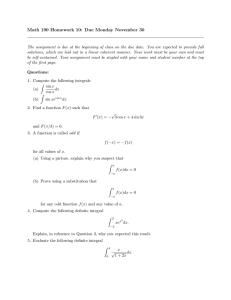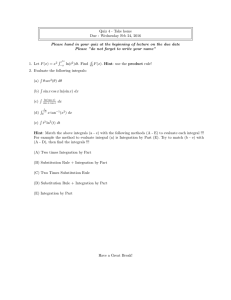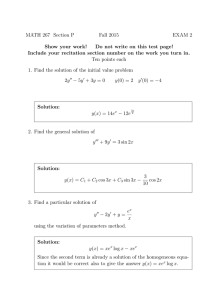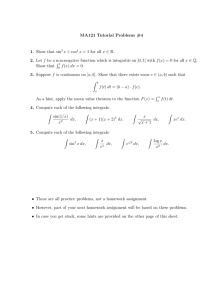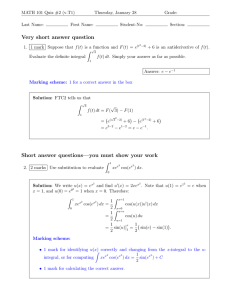10/12/12
advertisement
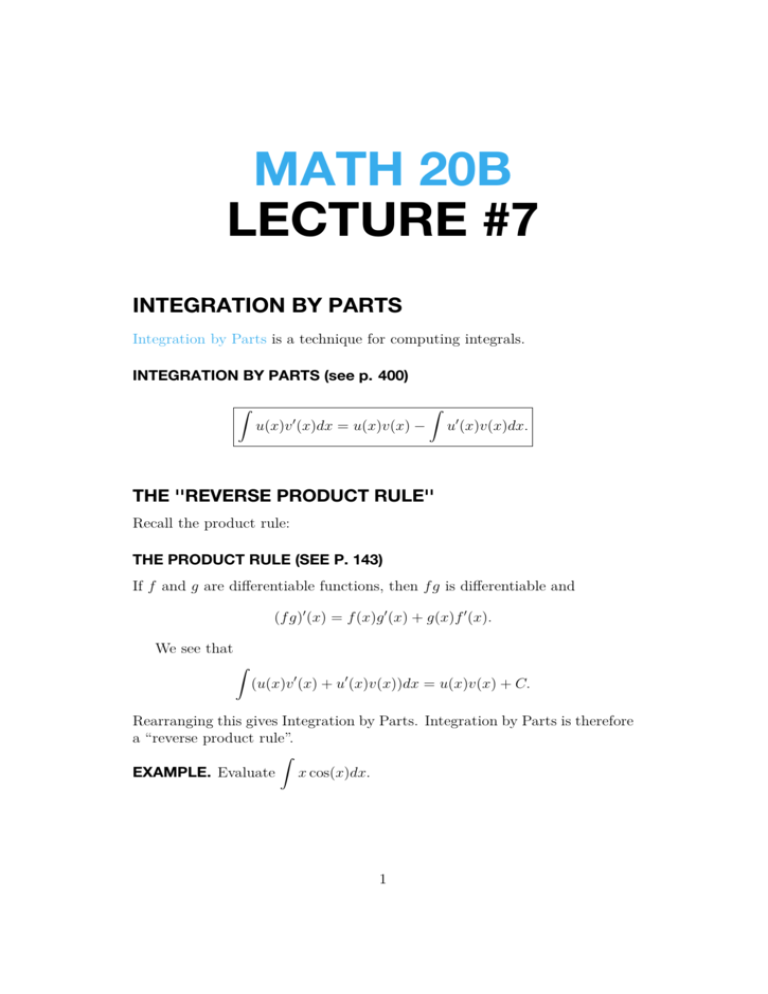
MATH 20B LECTURE #7 INTEGRATION BY PARTS Integration by Parts is a technique for computing integrals. INTEGRATION BY PARTS (see p. 400) ∫ ∫ ′ u(x)v (x)dx = u(x)v(x) − u′ (x)v(x)dx. THE ''REVERSE PRODUCT RULE'' Recall the product rule: THE PRODUCT RULE (SEE P. 143) If f and g are differentiable functions, then f g is differentiable and (f g)′ (x) = f (x)g ′ (x) + g(x)f ′ (x). We see that ∫ (u(x)v ′ (x) + u′ (x)v(x))dx = u(x)v(x) + C. Rearranging this gives Integration by Parts. Integration by Parts is therefore a “reverse product rule”. ∫ EXAMPLE. Evaluate x cos(x)dx. 1 TIPS From the book (p. 401): • Choose u so that u′ is simpler than u itself. ∫ • Choose v so that v = v ′ dx can be evaluated. My tips: • For ∫ ∫ n x cos(x)dx, ∫ n x sin(x)dx, or xn ex dx, where n is a positive integer, pick u = xn . ∫ • For xn (ln(x))m dx, where m is a positive integer, and n ̸= −1, pick u = (ln(x))m . ∫ • In other cases of f (x)dx, many times u = f (x) and v ′ = 1 works. (This tip also mentioned in the book.) ∫ EXAMPLE. Evaluate xex dx. • Good: u = x and v ′ = ex . • Bad: u = xex and v ′ = 1. ∫ EXAMPLE. Evaluate ln(x)dx. INTEGRATING BY PARTS MORE THAN ONCE Sometimes we repeat integration by parts, and at each step the integral becomes more simplified. ∫ EXAMPLE. Evaluate x2 cos(x)dx. 2 A REDUCTION FORMULA From the book (see p. 402) ∫ ∫ x e dx = x e − n n x n x xn−1 ex dx. Proof. Do integration by parts with u = xn and v ′ = ex . ∫ EXAMPLE. Evaluate x3 ex dx. INTEGRATION BY PARTS FOR DEFINITE INTEGRALS Here is the formula: ∫ a b b ∫ b u(x)v (x)dx = u(x)v(x) − u′ (x)v(x)dx ′ a ∫ 3 EXAMPLE. Evaluate 1 a ln(x) dx. x2 SUBSTITUTION AND INTEGRATION BY PARTS Sometimes we need to do substitution before doing integration by parts. Often this is the case when part of the integral is sin(f (x)), cos(f (x)), ef (x) , or ln(f (x)), where f (x) is something other than x. ∫ EXAMPLE. Evaluate x cos(2x)dx. ∫ EXAMPLE. Evaluate x5 sin(x2 )dx. ∫ EXAMPLE. Evaluate √ √ xe x dx. MIDTERM #1 Midterm #1 is Friday, October 19 and covers Sections 5.2-5.6, 6.1-6.3, and 7.1, i.e, everything we have covered up to this point. 3
